#had to post them separately because you gotta appreciate both their designs fully
Explore tagged Tumblr posts
Photo




They irritating! From right to left : Mona Lisa ( @sharkonaut-draws and @hersheyotaku ) and Mona Lisa ( @miicycle and @chubs-deuce) And also a close up too because I can

#my art#oc fanart#mona lisa squared XD#chubiiverse mona#hersharkverse mona#so in love with the expression I gave them#just two gals having a good time#I feel like they'd get along so well#had to post them separately because you gotta appreciate both their designs fully#there are so many pretty lady oc in the server I'm so weak#jojo-rolo
89 notes
·
View notes
Text
Sonic and speed: are we misunderstanding them?
This article was originally written in Spanish by @latin-dr-robotnik on his blog - you can read it here!
Today on SHP, I’d like to bring attention to a topic that I keep noticing being discussed everywhere (especially now during quarantine), and that somehow worries me: are we misunderstanding Sonic and his characteristic speed?
During these last few weeks there has been a new, relatively unusual explosion of videos and comments on the Internet regarding Sonic and, relevant for today, what is the best game or the best level. The simplest reason has to be the lockdown we’re going through, and which is leaving us with more time to play or think about those games we want to play, or never will. On the other hand, the most cynical side of me believes that this boom of Sonic-related content is because Game Apologist’s video about S3&K and Sonic in general was so popular, it sparked the “interest” of other creators (the video itself is great, and I elaborated my opinions on it here). Whatever the case, there is a greater discussion about Sonic going on right now, and I feel like it’s not directed where it should be.
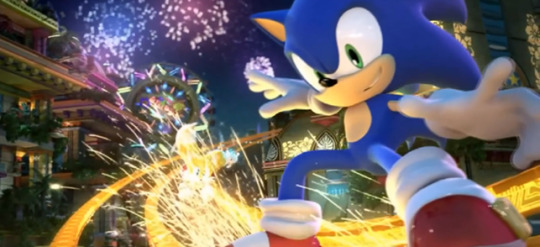
Before starting: there are a bunch of videos that helped me shape a good part of the opinions I’m going to explain today. You don’t need to watch all of them, and they’re not mandatory to fully understand this article, but if after reading it you’re left wanting for more, or you’d like to hear different options, I’d recommend you watch these:
1. Sonic and Speed (Errant Signal)
2. The First Levels of Sonic Games (Super Bunnyhop)
3. SONIC the HEDGEHOG: How Level Design Can Break a Game (Broken Base Gaming)
4. How Sonic Mania Makes a Level (RelaxAlax)
5. City Escape is Peak Sonic Game Design (ZoomZike)
6. Lost Valley Is Not Peak Sonic Game Design (ZoomZike)
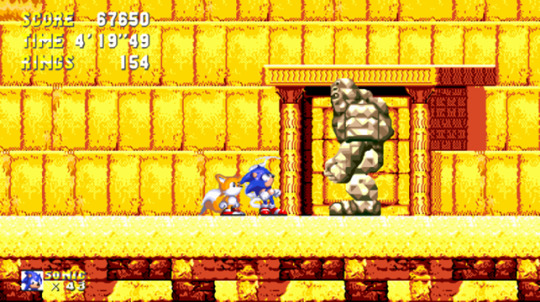
What is the problem?
In a series as big and ever-changing as Sonic’s, there is a wide repertory of formulas and possible answers to the question “how to design a game?”. In some cases we’re still looking for an answer, in others we’re looking for alternatives (I talked not too long ago about the accessibility of Sonic Mania and 2D Sonic in general – Spanish only!), and most of the time, the answer has already been given in the past.
This looking for answers in the past has taken us in many directions, like constantly looking back to Sonic Adventure to solve the great enigma that is 3D Sonic; but I’d add that the recent retrospectives about Sonic and its first 2D games have raised some criticism and questions that, while valid, end up muddling a formula that has proven itself to be effective and crucial in the design of everything related to Sonic.
What really worried me is the criticism about Sonic’s speed and the levels that are considered “slow”, and we’re going to delve into this.

The basic Principles of Sonic
Speed. Platforming. Exploration. These are Sonic’s basic Principles and have always been, from its beginning until today. These three concepts are at the core of not just the level design, but the games themselves as well. The best levels in the series know how to balance these aspects, and the best games are those that can keep a balanced flow, preventing the game from going too fast, and losing its exciting component along the way, or from going too slow and becoming boring, causing the player to lose interest. Naturally, in these games there have to be all sorts of levels: faster, more relaxed, more open and more labyrinthine, all coexisting in harmony and without going too far in one direction. Ignoring these Principles puts the quality of the levels at risk, and even our understanding of the character.
I would have put my own examples here, but just before starting to write this section I got some wonderful ones from Beevean. If you don’t remember her, she helped a lot with the article about the music of Classic Sonic, and I already warned her that if she kept posting examples this good, I would have had no choice but to feature her again. The discussion started from this post, and she says:
If you approach Sonic thinking its only characteristic is “gotta go fast”, the game you’re gonna get is Advance 2. The very flat, boring, “there’s no way to put normal obstacles in these levels so we’re gonna throw bottomless pits at the player until they get sick of them” Advance 2.
Some fast levels can be awful - Stardust Speedway is a disaster from a level design standpoint and the whole level seems to work against you. Some slow levels can be super fun - you rarely run in Lava Reef and you spend most of the time dodging obstables, but that doesn’t stop it from being one of the most beloved levels in S3&K. There’s no arbitrary reason that separates “good” levels from “bad” levels, it’s an amalgamation of many factors - plus of course your personal enjoyment.
And in her tags (because we both include more information in our tags than in our posts) she adds:
The levels that are widely considered bad usually put too much focus on one of the factors you mentioned.
Marble Zone is too slow and linear.
Luminous Forest is too fast and linear.
The Doom and Lost Impact are too labyrinthine.
And so on.
My personal example is Sonic Mania and its progression during the mid-game, from Flying Battery to Mirage Saloon:

Flying Battery is a long level, filled to the brim with speed and emotions, especially during Act 2. After beating the boss, the player is likely going to feeling exhausted after being thrown left and right, and so…
The following level is Press Garden. Act 1 is a relatively closed and relaxed level, but still moving at a reasonable pace. If the player is familiar with the level they can finish it quickly, but they still can take their time appreciating the view of the printing and the machinery of the zone. Act 2 enhances this, with an absolutely lovely view and an active but still relaxed flow…
Then there’s Stardust Speedway, which is divided into two completely opposite acts. Act 1 is a relatively fast level, but very relaxed and almost a Zen-like experience when the player lets himself be carried away by the starry night sky, and with a relative absence of lights or discomfort on the screen (enemies and obstacles aside). Act 2 is the other way around, a largely colorful, explosive, fast level (to the point that I, anything but a speedrunner, managed to finish the level in 31 seconds, 2:10 minutes if you include the fight with Metal Sonic), culminating in one of the longest, most intense bosses in the game that marks the halfway point of the adventure…
After such an exciting journey, the next level is Hydrocity, once again split in half with a calmer, more exploration-oriented Act 1, and an Act 2 that, similarly to the original level, is one of the most adrenaline-filled water levels in the series. The boss is intense as well, but verging on being tedious and not nearly as fast as the level itself…
And finally, Mirage Saloon. Every version of Act 1, regardless of the quality, are there to set up Act 2, a largely open, fast-paced level.
In short, the Mania experience is made of peaks and valleys of emotions and adrenaline, keeping the game to a reasonable pace and with a good dose of speed, exploration and platforming. The player can break the flow anytime to look for Giant Rings and other hidden goodies, and that doesn’t ruin the charm of the level. In the same way, the faster levels require the player to be familiar with them and to know how to platform to get the best results, without giving you free speed like it’s not worth it (looking at you, Advance 2).
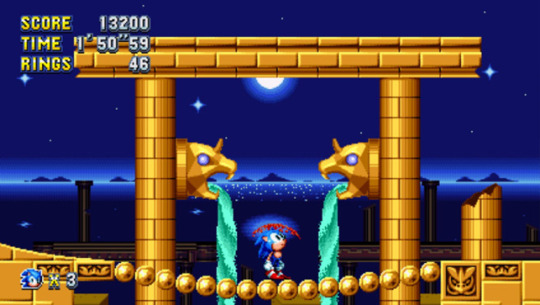
Even the worst levels have the chance to redeem themselves, like for example Labyrinth Zone in the “Misfit Pack” Mania mod.
Breaking the Principles.
When a level or a game breaks the balance for too long, it might become too easy (the infamous “hold right to win”), too boring (the most common argument against Sonic 1 because of levels like Marble Zone and Labyrinth Zone), or too obtuse (the criticism against Sonic CD). The key word is “for too long”, as Beevean already explained how levels that prioritize one thing over the others can still be considered good stages by the majority of the fandom (example: Lava Reef, and I’d add Spring Yard and Final Egg).
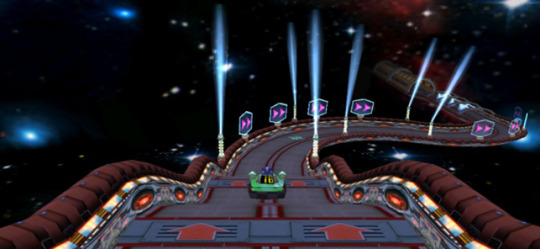
As I said before, Mania shows us how there are levels that prioritize certain aspects, but only for a few minutes at a time. Mirage Saloon Act 1 for Sonic and Tails may be a slow, boring level, but it’s only 3 minutes long in a game that lasts 2-4 hours. Same goes for Carnival Night Act 2, a long, tedious level, but that is still a 4-9 minutes long interval before getting back on track with Ice Cap and Launch Base.
3D Sonic is a much more complicated situation, as every game has its pros and cons. Adventure 1 is one of the games that experiments the most with the Principles in a 3D plane, but it breaks the flow of the stages with the plot and hubs worlds to explore (which are pretty divisive even to this day; for the record, on this blog we’re pro hubs). Adventure 2 gets rid of the time-wasting hubs but each character focuses on one Principle at the time: Sonic and Shadow focus almost exclusively on speed with some platforming, Tails and Eggman on action and platforming, and Knuckles and Rouge are all about exploration (and RNG…). Sonic Unleashed does pretty much the same, just reintroducing the hub worlds, while Sonic Generations is at its core a balanced mix of speed, platforming and exploring (plus a much smaller hub between levels), and… well, I think I made myself clear. 3D Sonic is a mess of ideas that orbit around the fundamental Principles, but that for some reason are never kept consistent between games.
Going back to utterly breaking the Principles, there’s one level above all that destroys every one of those extremes, never taking the middle road and without worrying at all about what players might think of it. This level is…
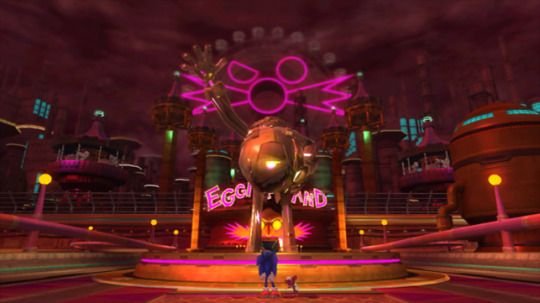
Eggmanland
If Sonic Mania is a clear example of a relatively balanced flow, in its mid-game at least, Eggmanland may be the biggest example of what happens when each and every one of the Principles is taken to its extremes. Let me explain:
Speed: Eggmanland can be both too fast for the player to react, between QTE and super quick jumps that may lead to your death if you’re not fast enough (and you rarely will), or too slow of a slog to navigate (the long Werehog sections).
Platforming: Eggmanland can have too much tricky precision platforming, made even harder due to a lack of a drop shade (the second Werehog section is infamous for this), or it can throw stretches where you do almost nothing but hold X and maybe go through a QTE, which if failed lead to your death once again; at worst you have to wait, which sends us back to our previous point.
Exploration: Eggmanland can be a giant, confusing labyrinth (there is no shortage of stories of player getting lost in this behemoth of a level), and at the same time it can have some long linear room to room progression, separated by doors about as fast as Big the Cat.
I should say that, despite all of this, I love Eggmanland a lot, and same goes for Beevean; but this is something that has to do with what we mentioned before, personal preference. From a technical standpoint, and according to many players, Eggmanland is an absolute nightmare.

Are we misunderstanding Sonic?
Going back to the central topic of this article, I believe that I put enough emphasis on the importance of balance in Sonic, so let’s go back to the previous question: what is the problem?
In short, I disagree with the voices that call for redirecting Sonic towards “fast”, adrenaline-filled stages. These people, with their own retrospective, are doing some sort of revisionism with Sonic levels, automatically branding levels that aren’t as fast as others as “bad”. We’re ignoring the true value of platforming and exploring the levels, and the perception of the character is at risk.

Like Beevean said, looking at Sonic just as “gotta go fast” is, plain and simple, absurd. Sonic is much more than this restless teenager that, just like that movie with the bus, if he doesn’t run at speeds higher than 90 mph his heart will stop. Yes, going fast is a big part of his initial appealing and his way of life (“My stories only end when I stop running”); but when Sonic’s speed is brought up in these discussions, the rest of what makes the character is left outside: how much he admires nature and how much he likes to take a rest every now and then before the next adventure. Sonic OVA, Sonic Adventure, Sonic X and even Sonic Lost World’s ending show that Sonic is not just speed, but also rest, curiosity, exploration. There are even cases where the journey and the friends and memories made along the way are much more important than the destiny itself (Sonic Heroes, Sonic Unleashed), and on several occasions it’s been shown as an actual weakness of the character the fact that he would act recklessly and under the influence of the fateful “gotta go fast”. This aspect of Sonic’s attitude might probably be product of the aggressive marketing campaigns this character endured (ever since the Genesis “Blast Processing”), but it doesn’t tell the whole story, and it’s unacceptable to enforce this line of thought over everything we know about the character.
And to end this long section where I was hinting at one of the most important points of one of the most thoughtful games of the series, let’s not forget that Sonic is pretty aware that everything has a beginning and an end, because that’s the Nature’s way of things and we have to live life at its fullest, for it is finite. Running at top speed is just one of many ways Sonic lives his life, and his eyes will forever be filled, not so much with speed, but with curiosity.
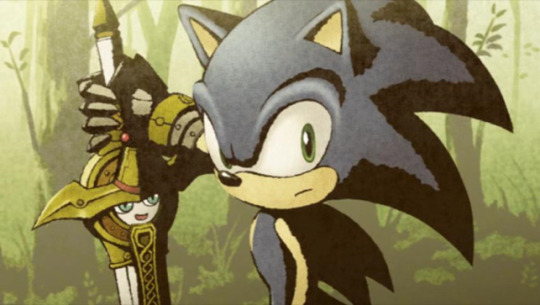
Conclusions
To recap this long article, let’s remember that
Speed, Platforming and Exploration are the three basic Sonic Principles. The momentum in the games comes from the interaction between these elements.
Speed is not something that’s delivered for the sake of being delivered: it usually is a reward or an incentive to keep the player interested, engaged and excited for what’s to come.
Breaking the Principles impacts the experience of the game in many aspects… unless you’re Eggmanland and you’re breaking every single Principle in one level anyway.
To narrow Sonic down to just “speed” is to ignore everything else that this character represents. “Gotta go fast” is a facet of his design and personality, but not the only one.
Starting from this, we can sit down and discuss about “good” and “bad” levels in the series all day long, but I don’t think it’s necessary. Now that we’re about to discover what’s next for the series, I believe it’s important to clarify what Sonic represents in every stage, so that with some luck we can see better consistency and quality in his future adventures.
Speaking of this last point, I just remembered The Geek Critique’s series of Sonic retrospectives, another series of videos that inspired me and I found enlightening. Do you guys remember the videos I linked to at the beginning? Well, it’s time for you to watch them :P (if you want to, of course)
(I’d like to thank Beevean again for suggesting the best examples I could have needed. Seriously, she helped much more than it looks)
What do you guys think? What is the ideal Sonic level, and why? Do you agree that Sonic is much more than a speedy blue hedgehog? In the meantime, we’re hopefully going to see each other very soon. See you next time!
youtube
I feel this theme is strangely fitting to conclude this article, lol
~
After the Spanish article was posted, I reblogged with this:
To add something more, I was chatting with a friend of mine who pointed out that, for all the talk in the fandom that we want to see less linear levels, most of the fan favorites are pretty linear - Ice Cap, Speed Highway, City Escape, Rooftop Run… I told him that yeah, linearity isn’t a synonym of bad level design because linear levels can still be enjoyable: with these particular cases, what makes them different from a random Lost Valley is that they have other elements that make them stand out (snowboarding, running down a skyscraper, skateboarding through San Francisco, climbing the Big Ben…). Plus they have something to compensate for the linearity, like fluid platforming.
In the case of Ice Cap and Speed Highway, there’s also a contrast between their halves: IC Act 1 is cramped and heavy on platforming, while Act 2 is much faster and without many obstacles, almost as a reward; Speed Highway starts out as fast and exhiliarating, with little platforming getting in the way of running, but the At Dawn section is a short open space, to let the player catch their breath, to the point that even the music and the aesthetic are much more relaxed. So, as you said, the balance is kept, and when you add a memorable setting and music, you have a great level in your hands.
Thank you @latin-dr-robotnik for giving me the permission to post this! I just had to translate this fascinating article to share it with everyone :>
131 notes
·
View notes